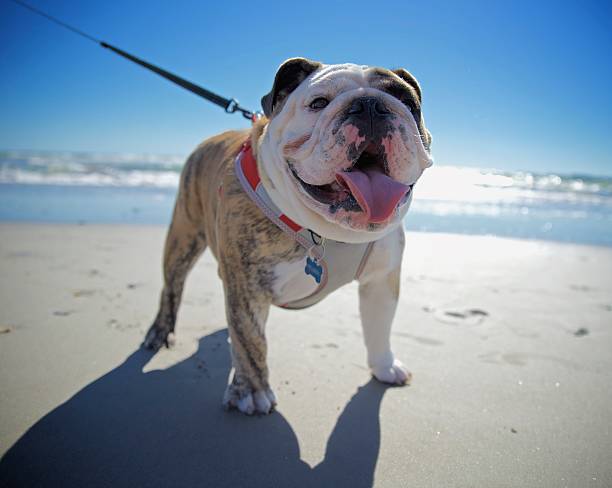The Dorset Old Tyme Bulldog, a captivating embodiment of resilience, adaptability, and friendly disposition, resonates deeply with those who seek a loyal and versatile companion. With its distinctive appearance, friendly nature, and adaptability, this breed has carved out a treasured niche as both a beloved family member and a testament to English canine elegance.

| Category (Explanation) | Breed Information |
|---|---|
| Year of Breed Conception | 19th century |
| Country of Origin | United Kingdom |
| Weight (Male) | 70-90 lbs (32-41 kg) |
| Weight (Female) | 60-80 lbs (27-36 kg) |
| Coat Type | Short, smooth |
| Color Variations | Brindle, white, fawn |
| Shedding Level | Low to moderate |
| Height (cm & in) | 51-61 cm (20-24 inches) |
| Breed Size | Medium to large |
| Trainability | Moderate |
| Mental Needs | Moderate |
| Intelligence Level | Moderate |
| Energy Level | Moderate to high |
| Agility | Moderate |
| Loyalty | High |
| Playfulness | Moderate to high |
| Exercise Needs | Regular exercise and play |
| Guarding Proficiency | Moderate |
| Sociability with Children | High |
| Barking Level | Low to moderate |
| Digging Tendency | Low |
| Destructive Behavior | Low |
| Drooling Level | Moderate |
| Obedience Level | Moderate |
| Apartment Friendly | Yes, with proper exercise and space |
| Inherent Prey Drive | Moderate |
| Physical Risk to Others | Low to moderate |
| Travel Fatality Risk | Low |
| Allergen Potential | Low (considered hypoallergenic) |
| Health Concerns | Hip dysplasia, joint issues |
| Average Life Expectancy | 10-12 years |










































































Woof Mastery is reader supported and our articles may contain affiliate links.
Instead of running third party ads that we have no control of we only use links from high-quality companies we are directly partnered with. Making use of these links come at no cost to you our reader, and in many cases have the extra benefit of discounted rates or sign up bonuses.
If you’re interested you can read more about our affiliate policy here.
We appreciate your support and always insure that the products and services we recommend are high-quality, helpful and relevant to the subject at hand!
The Dorset Old Tyme Bulldog’s history takes us to the United Kingdom in the late 20th century. Bred as a healthier and more athletic alternative to traditional bulldog breeds, they were developed through selective breeding.
The goal was to create a bulldog that retained the breed’s iconic appearance while promoting better health and agility. The breed’s journey from the classic bulldog to a more vibrant and active companion showcases their adaptability and commitment to preserving their heritage.
Today, Dorset Old Tyme Bulldogs are celebrated for their vitality, loyalty, and their connection to the historical legacy of bulldog breeds.

What sets the Dorset Old Tyme Bulldog apart is its dedication to preserving the classic bulldog qualities while promoting better health. These dogs have a muscular build and a distinctive appearance reminiscent of traditional bulldogs. Dorset Old Tyme Bulldogs balance their traditional looks with a loving and friendly nature. They are known for their gentleness, making them excellent family pets.
Their commitment to preserving bulldog heritage while prioritizing health and well-being sets them apart and makes them special to those who value both tradition and the vitality of their canine companions.
The traditional role of the Dorset Old Tyme Bulldog included working as versatile farm dogs, assisting with tasks such as herding and guarding. They excelled in agility and strength, contributing to the success of various agricultural activities. Today, they continue to thrive as affectionate family pets, offering both companionship and a touch of athleticism to their owners.
Dorset Old Tyme Bulldogs are renownedfor their friendly and affectionate personalities. They are often referred to as gentle giants, owing to their loving and patient disposition, which makes them ideal companions for families, including those with children.
Their intelligence and adaptability are noteworthy, making them trainable and versatile pets. Dorset Old Tyme Bulldogs may exhibit caution with strangers, but their loyalty to their families is profound. They possess a unique blend of confidence, courage, and a strong sense of duty, making them dependable and trustworthy pets that bring joy to any household.
Dorset Old Tyme Bulldogs are known for their friendly and affectionate temperament. They are often referred to as gentle giants, owing to their loving and patient disposition, which makes them ideal companions for families, including those with children.
Their intelligence and adaptability are noteworthy, making them trainable and versatile pets. Dorset Old Tyme Bulldogs may exhibit caution with strangers, but their loyalty to their families is profound.
They possess a unique blend of confidence, courage, and a strong sense of duty, making them dependable and trustworthy pets that bring joy to any household. Early training and socialization are pivotal to fostering a well-adjusted temperament in this breed.
Dorset Old Tyme Bulldogs are medium-sized, well-muscled dogs with a distinctive, square-shaped head and a well-defined jaw that adds to their charming and expressive face.
Their medium-sized, expressive eyes often come in shades of brown, conveying warmth and affection. Ears are medium-sized and naturally fold forward, contributing to their endearing appearance.
These dogs have a short, smooth coat that comes in various colors, with white being predominant and often accompanied by patches of brindle, fawn, or black. Their skin is loose, especially around the neck, creating a wrinkled and lovable expression.
The neck is strong and well-defined, leading to a broad chest and sturdy, straight legs, ensuring their agility and strength. The tail is straight and tapered, adding to their balanced and harmonious physique.
In terms of size, males stand around 18-20 inches (46-51 cm) at the shoulder, and females are slightly smaller. Weight ranges from 55 to 80 pounds (25-36 kg) for males and slightly less for females. Dorset Old Tyme Bulldogs possess an appearance that reflects their robust and agile nature, making them affectionate and loyal companions.
Overall, Dorset Old Tyme Bulldogs have well-proportioned bodies, reflecting their versatile roles on farms. Their appearance exudes strength, confidence, and athleticism, with males often presenting a more robust and imposing presence compared to females, emphasizing their historical importance as reliable working dogs.
Dorset Old Tyme Bulldogs are robust and athletic dogs that come in a range of appealing color variations, including:
Dorset Old Tyme Bulldogs have a moderate shedding level. While they are not heavy shedders, they may shed year-round, with shedding potentially increasing during seasonal transitions. Consistent grooming and brushing with a bristle brush or a deshedding tool once or twice a week can be beneficial in managing shedding and maintaining their coat’s quality.
Factors affecting shedding in Dorset Old Tyme Bulldogs include genetics, overall health, and diet. Regular exercise and a well-balanced diet contribute to coat health and may reduce shedding. Providing a stress-free environment can help minimize stress-related shedding.
Dorset Old Tyme Bulldogs, an embodiment of vintage Bulldog aesthetics, boasts a coat that requires dedicated grooming.
Brushing: Bi-weekly sessions using a rubber grooming mitt, followed by a soft-bristle brush, can manage shedding and ensure coat health.
Bathing: Depending on their outdoor escapades, a 4-6 week bathing routine, using a gentle dog shampoo, is advisable.
Ears: Given their medium size and curvature, their ears can often trap debris. Regular cleaning, preferably weekly, is advised.
Nails: Their robust build necessitates well-maintained paws. Regular trimming, combined with occasional filing, can prevent overgrowth.
Teeth: Daily brushing, combined with dental toys and treats, can prevent potential gum issues and ensure oral health.
Wrinkle Care: The breed’s distinct wrinkles, especially around the face, should be cleaned daily, ensuring they remain dry and bacteria-free.
Eye Care: Their soulful eyes require daily checks. Cleaning them weekly with a damp cloth can keep them free of irritants.
Dorset Old Tyme Bulldogs have a moderate activity level. They are known for their gentle and friendly nature. Here are some key points to consider about their activity level:
Dorset Old Tyme Bulldogs exhibit moderate intelligence, characterized by adaptability, problem-solving abilities, and a strong desire to please their owners. Here are key points about their intelligence:
The Dorset Old Tyme Bulldog may not be as widely recognized as some other breeds, but their intelligence is evident in their trainability, problem-solving skills, and loyalty. They excel as both working dogs and affectionate family companions. Training, socialization, and mental stimulation are essential to help them reach their full potential.
Dorset Old Tyme Bulldogs love cognitive games. Incorporate intricate toys, obedience chores, or pair activities.
Social Interaction: Dorset Bulldogs cherish human contact. Prolonged absence can make them anxious.
Exercise: Dorset Bulldogs need consistent physical outings. It aids in keeping them mentally and physically agile.
Training and Obedience: Obedience training is crucial for Dorset Bulldogs. Positive reinforcement ensures better learning outcomes.
Routine and Structure: Dorset Bulldogs thrive on predictability. A well-organized daily life keeps them anchored and happy.
Affection and Attention: Dorset Bulldogs are incredibly loving. Spend quality moments with them to foster a deep bond.
Socialization: Dorset Bulldogs benefit from early and varied exposures. It molds them into well-balanced adults.
Safe Environment: Ensure a warm, secure nook for your Dorset Bulldog. A place where they can rest and feel sheltered is essential.
Consistency: Maintaining a steady routine in activities and training ensures Dorset Bulldogs feel safe and confident.
Enter The Woof Mastery

Before bringing a Dorset Old Tyme Bulldog into your home, it’s crucial to understand their needs. These dogs are known for their friendly and adaptable nature. They require regular exercise and mental stimulation to stay happy and healthy. Training and socialization are essential to ensure they are well-behaved.
Be prepared for potential health concerns specific to the breed, including joint issues. Grooming needs are relatively low. Responsible ownership involves providing a loving and secure environment for these loyal and versatile companions.
Dorset Old Tyme Bulldogs, known for their sturdy build and loyalty, typically pose a lower potential physical danger to others compared to some larger breeds. However, like any dog, their behavior depends on factors such as individual temperament, upbringing, training, and owner responsibility. Here are some considerations regarding their potential physical danger:
Dorset Old Tyme Bulldogs are renownedfor their friendly and affectionate personalities. They are often referred to as gentle giants, owing to their loving and patient disposition, which makes them ideal companions for families, including those with children.
Their intelligence and adaptability are noteworthy, making them trainable and versatile pets. Dorset Old Tyme Bulldogs may exhibit caution with strangers, but their loyalty to their families is profound. They possess a unique blend of confidence, courage, and a strong sense of duty, making them dependable and trustworthy pets that bring joy to any household.
Dorset Old Tyme Bulldogs, reminiscent of bulldogs from bygone eras, possess unique characteristics that affect their swimming capabilities. Here’s what to consider:
While some Dorset Old Tyme Bulldogs might find swimming enjoyable, it’s essential to be attuned to their comfort levels and always ensure their safety.
Dorset Old Tyme Bulldogs, known for their strong and protective nature, may express themselves through various vocalizations. Here are some common noises they may make:
Owners of Dorset Old Tyme Bulldogs should pay attention to these vocalizations, understanding the context in which they occur. While some noises are part of their charming personality, others may signal a need for attention or care. Positive reinforcement training can be beneficial in managing and adapting their vocal behaviors.
Dorset Old Tyme Bulldogs thrive in homes where they receive love, structure, and opportunities for socialization. Here are some ideal living conditions for Dorset Old Tyme Bulldogs:
Challenges:
When it comes to travel fatality risk for Dorset Old Tyme Bulldog, consider the following potential constraints:
By addressing these potential constraints and taking necessary precautions, you can help ensure the safe travel of your Dorset Old Tyme Bulldog and minimize travel-related risks.
Dorset Old Tyme Bulldogs may be prone to specific health concerns. While not all individuals will experience these issues, it’s essential for owners to be aware of potential health problems and work with veterinarians to maintain their pets’ well-being. Common health concerns include:
Regular veterinary check-ups, a balanced diet, proper exercise, and responsible breeding practices can help mitigate some of these health concerns. It’s crucial for Dorset Old Tyme Bulldog owners to work closely with their veterinarians to monitor their pets’ health and address any issues promptly.
Maintaining the right nutrition is essential for the vitality and overall health of Dorset Old Tyme Bulldogs. Here’s a guide to the dietary recommendations and best practices for this specific breed:
Breed-Specific Laws (BSL): Dorset Old Tyme Bulldogs may occasionally be under the purview of breed-specific laws (BSL) in certain areas. Such laws are generally set in place at the municipal or local level, with distinct regulations between regions.
Types of Restrictions: BSL impacting Dorset Old Tyme Bulldogs could mandate spaying/neutering, distinct licensing, liability insurance stipulations, muzzling in public areas, and sometimes, ownership bans, all based on regional regulations.
Rationale for BSL: BSLs commonly arise due to apprehensions about public safety linked to specific breeds. While Dorset Old Tyme Bulldogs have an old-world charm, they might face BSL due to their bulldog classification.
Controversy: The discussion around BSL is ongoing, with many suggesting that these laws might not address the root issues and that responsible dog ownership should take precedence.
Local Regulations: Potential Dorset Old Tyme Bulldog owners should acquaint themselves with local regulations by liaising with local animal control or relevant authorities to remain compliant.
Woof Mastery is reader supported and our articles may contain affiliate links.
Instead of running third party ads that we have no control of we only use links from high-quality companies we are directly partnered with. Making use of these links come at no cost to you our reader, and in many cases have the extra benefit of discounted rates or sign up bonuses.
If you’re interested you can read more about our affiliate policy here.
We appreciate your support and always insure that the products and services we recommend are high-quality, helpful and relevant to the subject at hand!
Myth 1: Dorset Old Tyme Bulldogs are Aggressive by Nature
Myth 2: They are High-Energy Dogs
Myth 3: They Can’t Tolerate Cold Weather
Myth 4: They are Not Good with Children
Myth 5: They Shed Excessively
Myth 6: They Don’t Require Training
Myth 7: They are Always Good with Other Dogs
Myth 8: They Are All the Same Size
Myth 9: They are Unhealthy Dogs
Myth 10: They are Always Clingy
The Dorset Old Tyme Bulldog holds cultural significance in various contexts:
While there may not be as many famous Dorset Old Tyme Bulldog owners as there are for other dog breeds, here are a few notable individuals who have been associated with Dorset Old Tyme Bulldogs:
Dorset Old Tyme Bulldogs, like many other dog breeds, have faced several threats and challenges over the years. Some of the significant threats and issues that have affected the breed include:
The Dorset Old Tyme Bulldog is believed to have been developed from a combination of various breeds, with the primary ancestors being Bulldogs of the 18th and 19th centuries. The breed’s development was influenced by the desire to recreate Bulldogs from an earlier era. The specific breeds and strains that contributed to the Dorset Old Tyme Bulldog’s development include:
Dorset Old Tyme Bulldogs are a harmonious blend of strength and charm, epitomizing the spirit of cherished family pets. With their robust physique and loving disposition, they seamlessly integrate into our lives, providing not only security but also heartfelt devotion.
These dogs excel as watchdogs, displaying protective instincts that solidify their role as guardians of our homes. Dorset Old Tyme Bulldogs are known for their adaptability, thriving in various living conditions, and requiring only minimal grooming. Their athletic prowess and playful spirit cater to active individuals and families, making them excellent playmates. Their intelligence shines in activities and training.
Beyond their physical attributes, Dorset Old Tyme Bulldogs bring a unique charm to every household, filling the air with their presence. Their versatility is a testament to their adaptability, transitioning effortlessly from beloved family pets to diligent working dogs.
Most importantly, Dorset Old Tyme Bulldogs offer an unparalleled gift—profound and unconditional love. They become treasured family members, enriching our lives with their unwavering companionship and forging an unbreakable bond that lasts a lifetime. Embrace the incredible love and devotion that Dorset Old Tyme Bulldogs have to share.